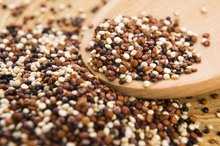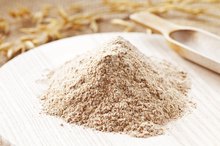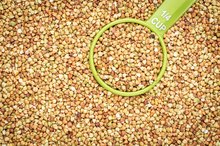What does fact checked mean?
At Healthfully, we strive to deliver objective content that is accurate and up-to-date. Our team periodically reviews articles in order to ensure content quality. The sources cited below consist of evidence from peer-reviewed journals, prominent medical organizations, academic associations, and government data.
- Journal of Food Science: State of Knowledge on Amaranth Grain: A Comprehensive Review
- Journal of Food Science: State of Knowledge on Amaranth Grain: A Comprehensive Review
- Cell Biochemistry and Function: Antioxidative and Anti-Diabetic Effects of Amaranth (Amaranthus Esculantus) in Streptozotocin-Induced Diabetic Rats
- Cell Biochemistry and Function: Antioxidative and Anti-Diabetic Effects of Amaranth (Amaranthus Esculantus) in Streptozotocin-Induced Diabetic Rats
- Harvard Medical School: Glycemic Index and Glycemic Load For 100+ Foods
The information contained on this site is for informational purposes only, and should not be used as a substitute for the advice of a professional health care provider. Please check with the appropriate physician regarding health questions and concerns. Although we strive to deliver accurate and up-to-date information, no guarantee to that effect is made.
Amaranth & the Glycemic Index
The glycemic index estimates how much eating a particular food may affect your blood sugar levels, making it a valuable resource for diabetics. Choosing foods with a glycemic index closer to zero may help limit large changes to your blood sugar levels, while foods with scores closer to 100 could cause spikes in your blood sugar. When it comes to amaranth, the glycemic index depends on how processed it is as well as what you serve along with it. However, foods made with this grain tend to be high on the glycemic index.
Amaranth Flour
Amaranth is sometimes toasted and ground into a flour. This processing may increase the glycemic index compared to the unprocessed grain, as flours typically have higher glycemic indexes than intact grains because they are more quickly digested. A mix consisting of half amaranth and half wheat has a GI of 75.5, and a mix containing 25 percent amaranth and 75 percent wheat has a GI of 65.6, similar to that of wheat alone, which has a GI of 65.7. Anything with a GI between 56 and 75 is considered moderate on the glycemic index, and scores of 76 and above are considered high.
- Amaranth is sometimes toasted and ground into a flour.
- A mix consisting of half amaranth and half wheat has a GI of 75.5, and a mix containing 25 percent amaranth and 75 percent wheat has a GI of 65.6, similar to that of wheat alone, which has a GI of 65.7.
Popped Amaranth With Milk
List of Grains With Low GI
Learn More
Amaranth is also sometimes popped and served as a cereal along with milk. This combination has a high glycemic index, with a score of 97.3. The popped amaranth alone would be even higher on the glycemic index because milk itself has a low GI between 32 and 41, depending on the type of milk you choose.
Amaranth and Diabetes
Although amaranth has a high glycemic index, this doesn't necessarily mean it is off-limits for diabetics. A study published in "Cell Biochemistry and Function" in 2006 found that rats given amaranth grain or amaranth oil experienced increases in insulin levels and decreases in blood sugar. A review article published in the "Journal of Food Science" in April 2012 noted that amaranth may lower blood sugar, cholesterol and blood pressure levels 1. While further studies are needed to verify these potential benefits, it looks like amaranth may have some health benefits for diabetics when consumed it moderation.
- Although amaranth has a high glycemic index, this doesn't necessarily mean it is off-limits for diabetics.
- A study published in "Cell Biochemistry and Function" in 2006 found that rats given amaranth grain or amaranth oil experienced increases in insulin levels and decreases in blood sugar.
Fitting Amaranth Into a Low-GI Diet
Wheat Germ and Glycemic Index
Learn More
To include amaranth while following a low-glycemic index diet, eat it along with lean protein foods, foods high in unsaturated fat or those that are low on the glycemic index. Low-GI foods include nonstarchy vegetables and select fruits like apples, oranges and pears, as well as foods naturally low in carbohydrates like nuts and seeds. Choose the less-processed whole amaranth instead of highly processed snack foods made with this grain. You can cook whole amaranth grains in water similar to the way you would cook rice, but using three parts water to each part amaranth.
- To include amaranth while following a low-glycemic index diet, eat it along with lean protein foods, foods high in unsaturated fat or those that are low on the glycemic index.
- Low-GI foods include nonstarchy vegetables and select fruits like apples, oranges and pears, as well as foods naturally low in carbohydrates like nuts and seeds.
Related Articles
References
- Journal of Food Science: State of Knowledge on Amaranth Grain: A Comprehensive Review
- Observations Regarding Consumption of Peruvian Native Grains (Quinoa, Amaranth and Kaniwa), Weight Status, and Perceptions of Potential Risk Factors, Warning Signs and Symptoms of Type 2 Diabetes Among Peruvian Adults: A Case Study; Sanchez, K.
- Clinical Diabetes: The 3 R's of Glycemic Index: Recommendations, Research, and the Real World
- Cell Biochemistry and Function: Antioxidative and Anti-Diabetic Effects of Amaranth (Amaranthus Esculantus) in Streptozotocin-Induced Diabetic Rats
- Harvard Medical School: Glycemic Index and Glycemic Load For 100+ Foods
- Amaranth grain, cooked. FoodData Central. U.S. Department of Agriculture. Published April 1, 2019.
- Capriles VD, Coelho KD, Guerra-Matias AC, Arêas JA. Effects of processing methods on amaranth starch digestibility and predicted glycemic index. J Food Sci. 2008;73(7):H160-4. doi:10.1111/j.1750-3841.2008.00869.x
- Caselato-Sousa, Maria. Amaranth grain and its action on blood glucose level. Journal of Diabetes & Metabolism. November 2014.
- National Institutes of Health Office of Dietary Supplements. Dietary supplement fact sheets.
- Alonso-Miravalles L, O'Mahony JA. Composition, protein profile and rheological properties of pseudocereal-based protein-rich ingredients. Foods. 2018;7(5):73. doi:10.3390/foods7050073
- Caselato-Sousa VM, Amaya-Farfán J. State of knowledge on amaranth grain: A comprehensive review. J Food Sci. 2012;77(4):R93-104. doi:10.1111/j.1750-3841.2012.02645.x
- Aune D, Keum N, Giovannucci E, et al. Whole grain consumption and risk of cardiovascular disease, cancer, and all cause and cause specific mortality: Systematic review and dose-response meta-analysis of prospective studies. BMJ. 2016;353:i2716. doi:10.1136/bmj.i2716
- USDA ChooseMyPlate. Make half your grains whole grains. Updated October 2016.
- American Heart Association. Whole grains, refined grains, and dietary fiber. Updated September 20, 2016.
- Daily Nutritional Goals for Age-Sex Groups Based on Dietary Reference Intakes and Dietary Guidelines Recommendations. USDA Dietary Guidelines 2015–2020.
- Maki KC, Palacios OM, Koecher K, et al. The relationship between whole grain intake and body weight: Results of meta-analyses of observational studies and randomized controlled trials. Nutrients. 2019;11(6):1245. doi:10.3390/nu11061245
- Kasera R, Niphadkar PV, Saran A, Mathur C, Singh AB. First case report of anaphylaxis caused by Rajgira seed flour (Amaranthus paniculatus) from India: a clinico-immunologic evaluation. Asian Pac J Allergy Immunol. 2013;31(1):79-83.
- Vaswani R, Garg V, Khim B, Huang Y, Vaswani S. Anaphylactic reaction to amaranth (amaranthus paniculatus). Annals of Allergy, Asthma & Immunology. 2018;121(5):S113–S114. doi:10.1016/j.anai.2018.09.375
- Chaturvedi A, Sarojini G, Nirmala G, Nirmalamma N, Satyanarayana D. Glycemic index of grain amaranth, wheat and rice in NIDDM subjects. Plant Foods Hum Nutr. 1997;50(2):171-8. doi:10.1007/bf02436036
Writer Bio
Based in Massachusetts, Jessica Bruso has been writing since 2008. She holds a master of science degree in food policy and applied nutrition and a bachelor of arts degree in international relations, both from Tufts University.









